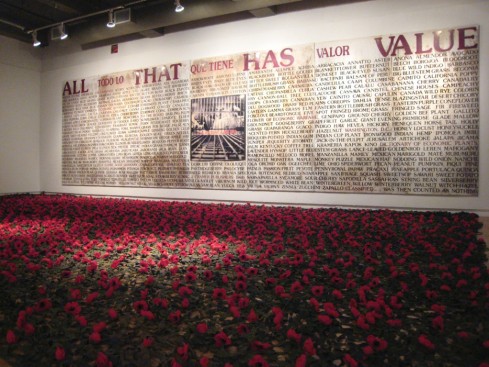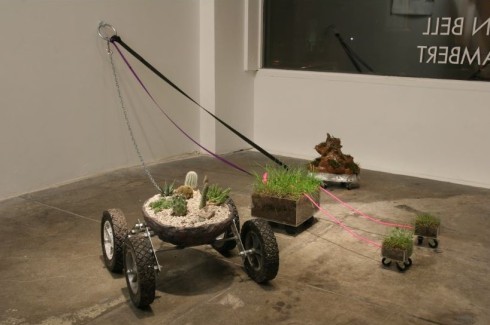The garden has long fascinated artists. Henri Rousseau, Claude Monet, Vincent van Gogh and Henri Matisse have all produced masterful works on this theme.
But that’s only the tip of the iceberg, for it doesn’t stop there. Gardens have a lengthy history in art and have yet to fall out of favour – no matter whether they may be real or mythological in nature. We know of the Garden of Eden, the ancient gardens of Egypt and the hanging gardens of Babylon. To the Ancient Greeks and Romans gardens served practical purposes and provided pleasure. In medieval art the garden could be a paradise as well as a landscape of horrors.

In recent times gardens have been touted as way to combat food prices, the agricultural industry and one’s lack of control over the food supply. Environmental awareness was the thing back in the mid-1970s. Jennie Klein has noted how back then the muppet character Kermit the Frog ‘s signature song was It’s not easy bein’ green.(1) Some people moved back onto the land and others brought the land indoors. A student at the art school I attended, for example, created large and small in various unused corners inside and around college buildings. In fact, some artists were at it a bit earlier. Take Hans Haacke. His Grass works have since been re-discovered and re-exhibited.


Writing in 2007 Klein lists a host of then current problems – the cost of fuel, the war in Iraq and climactic change – are again urging people to become environmentally active.(2) Then about a year later (and in the same publication), Berin Golonu zeros in on projects initiated by artists and architects that are greening urban and suburban spaces across the USA, mostly for the purposes of supplying food. (3) Examples include the temporary farm created by John Bela and Slow Food Nation in front of San Francisco’s City Hall and Fritz Haeg‘s Edible Estates, in which a partnership with home owners sees the traditional grass carpet of suburban front yards converted into food production sites.

Ron Benner approaches food from an alternate perspective. His practice combines tracking Native American plants – the eating of corn, for example, which came from Meso-America – along with themes that are political and ethnographic in nature.(4) He also collaborates with Jamelie Hassan to produce powerful installations in exhibitions such as The World is a Garden whose Walls are the State.

Other projects invest gardens with a sense of humour, atypical appearances, even movement. Gene Threndyle describe the garden as idealised nature. In response, his contribution to Toronto’s Harbourfront Centre’s Artists’ Gardens program (1990-2005) tried to be more honest. Called The Unnatural Garden (1995), this garden also conveyed attitude: Grumpy Garden; Tortured Topiary; Don’t Bother To Smell The Roses.
Rob Carter‘s interest lies in exploring the living spectrum, especially man’s relationship to plants, and creates works such as Faith in A Seed (2012), in which plants grow to engulf models of historic estates or his geometrical soil carpet at the Bemis Art Center in Omaha, Nebraska. Seeded with poppy seeds purchased from various local food stores, the installation gradually turned into a living floor mosaic.

Movement and miniaturisation comes into play in the work of artists Raimo Saarinen and Vaughn Bell. Saarinen’s Neosgaia (2016) consists of a group of small suspended islands. They appear to have been ripped out of the ground from some unspecified location and are on their way – somewhere. The roots of these plants of nothing but air to penetrate. Hovering in space much like a satellites, one can only guess at long they can survive.

Vaughn Bell produces tiny environments that situate themselves in unusual locations. They might be found on a barren stretch of sidewalk, dangling in miniature greenhouses or as part of a dome that doubles as a headpiece. In the latter work – Portable Personal Biosphere (2003-2004), they circle the wearer’s neck. Others are mounted on wheels and function as a pet substitute.

The final example, though it has been well publicised in the press, is still quite impressive and takes gardens on a totally unexpected trajectory. The work is an experiment that has been described as a self-driving greenhouse ball. It rolls itself around to expose all of its multi-directional residents to appropriate amounts of light. Designed by William Victor Camilleri and Danilo Sampaio of University College London’s Bartlett School of Architecture, it leaves me wondering: Does it have practical applications? and Where would it work best? But most of all, is it possible, if the idea really took off, could we see greenhouse ball congestion, dangerous bumper ball events, a new form of road rage?

References:
1 Jennie Klein, Curating Environmentalism for Post Industrial America, Art Papers, September/October 2007, p. 18.
2 Ibid.
3 Berin Golonu, Greening the Revolution: Sustainable Urban Gardening, Art Papers, November/December 2008, pp. 38-45.
4 Ann Ireland, Here and Away: The migrations of Jamelie Hassan and Ron Benner, Canadian Art, Spring 2016, pp. 110-115.

One thought on “Genre/Subgenre: Gardens”